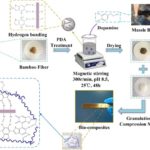Paper, Mussel-inspired polydopamine modification of bamboo fiber and its effect on the properties of bamboo fiber/polybutylene succinate composites
A bio-inspired approach to coating polydopamine (PDA) onto bamboo fiber (BF) was developed to enhance the poor interfacial bonding of BF/polybutylene succinate (PBS) biocomposites. (Reinforcing natural fibers with mussel adhesion techniques) Recently, energy shortages and environmental pollution have become a common human concern. For conventional plastics, such as PP, PE, PVC, etc., decomposing the ever-increasing amount of waste not only consumes a lot of energy, but also produces huge amounts of greenhouse gases. To combat these serious problems, a large number of biodegradable polymers, including polylactic acid (PLA), polybutylene succinate (PBS), polybutyleneadipate-co-terephthalate (PBAT), and polyhydroxybutyrate (PHB), have been exploited. However, their high prices limit their marketability. Fortunately, natural fibers derived from biomass resources have advantages, such as high strength, low cost, and being environmentally friendly, which makes them capable fillers to reinforce plastics, as well as reduce costs. Therefore, developing a biodegradable biocomposite that is polymerized by biodegradable polymers and natural fibers has attracted increasing attention. Polybutylene succinate (PBS) is a biodegradable polymer used in industrial applications. It can be obtained by the polycondensation of succinic acid and butanediol under certain conditions . However, pure PBS has a poor mechanical strength and other inadequate properties, which restrict its applications. Many studies have focused on the use of organic and inorganic fibers including jute, basalt, and carbon fibers to enhance the properties of PBS. Considering the full biodegradation performance, biomass fibers excel in this application. Among the diverse biomass fibers, bamboo fiber has been widely used to reinforce various plastics because of its high mechanical strength with a small microfibrillar angle (approximately 2° to 10°). Moreover, the fast growth of raw bamboo makes it easy to obtain. However, to date, studies on using bamboo fiber to prepare PBS-based composites have rarely been conducted.
Learn about our two Decals!
 Click here to find out more about our Fall Bioinspired Design Decal and our Spring Bioinspired Design in Action Decal – ALL MAJORS are welcome.
Click here to find out more about our Fall Bioinspired Design Decal and our Spring Bioinspired Design in Action Decal – ALL MAJORS are welcome.Berkeley BioDesign Community
 Click here to learn about the BioD: Bio-Inspired Design @ Berkeley student organization or here to signup for more info.
Click here to learn about the BioD: Bio-Inspired Design @ Berkeley student organization or here to signup for more info.Search
Student Login





I imagine that the neurological circuits underlying these processes are governed by both 2d spacing maps with their brains as…
to reduce the impact of car accidents, it may be possible to study the force diverting physics of cockroaches to…
you see this type of head-bobbing stability in many avian creatures related to pigeons like chickens. the head ability to…
not like they taught horses how to run! this is an example of convergent evolution where both sea creatures and…
The brain functions in a similar way with neuronal connections. our brains are able to utilize the multiplicity of connections…